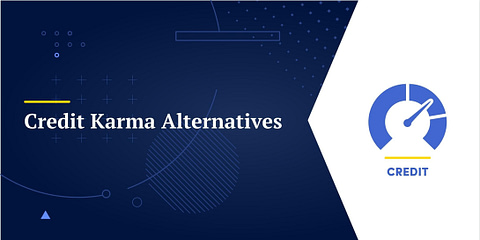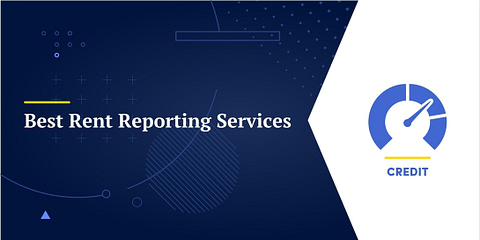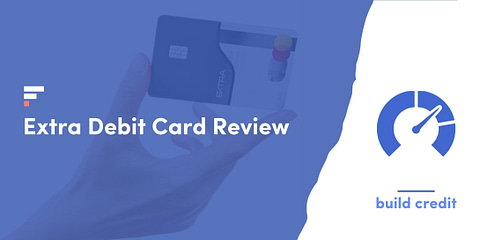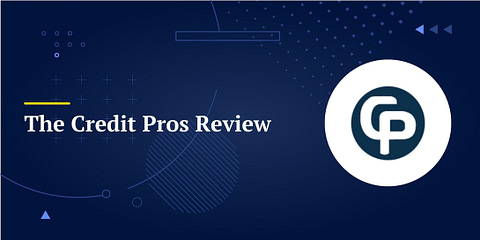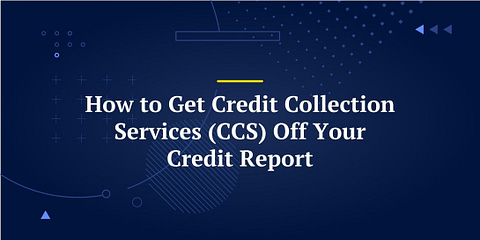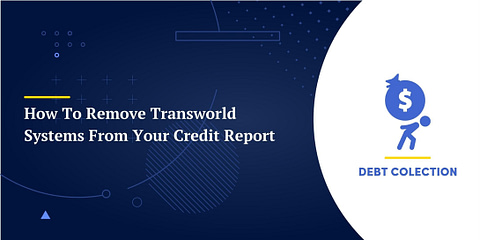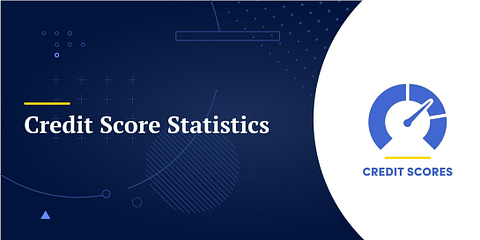Credit utilization is the percentage of your total available revolving credit that you are actually using at any given time. This key factor significantly influences your credit score, and improving this ratio can enhance your overall credit health.
💡 If you reduce your credit utilization you could see improvements in your credit score in as little as 30 days.
You can do this by reducing your credit card debt. You can also raise your total credit card limit by asking for a higher credit limit or opening a new card. Keeping credit cards open, even if you are not using them, can help you maintain a low rate, but you’ll have to weigh the gains against the fees and risks of having multiple cards.
Key Takeaways
- Credit utilization has a major impact on your credit score. Only your payment history has more influence on your score.
- Understanding your credit utilization ratio can help you improve it. If you know how your ratio is computed you’ll be more able to control it.
- Strive for Low Utilization. Aim to keep your credit utilization below 30% for a positive effect on your credit score; lower percentages are even better.
- Manage your balance and credit limit. Use strategies such as paying off debt, redistributing debt, and increasing credit limits to maintain a favorable credit utilization ratio.
Here is everything you need to know to optimize this critical part of your credit score.
How Do You Calculate Credit Utilization Ratio?
Credit utilization is based on revolving credit: credit cards and other short-term lines of credit that are not paid on a set schedule. It does not include mortgages, student loans, or auto loans which are considered long-term installment loans. Revolving credit carries over month to month without a predetermined payment date.
A revolving credit account usually has a credit limit. That is the maximum amount you can charge on the account. The percentage of that limit that you use is an indication of financial responsibility.
If you are using a low percentage of your credit limit, you are demonstrating responsible use of funds. If you max out your cards, you’re demonstrating the opposite.
There is a simple formula: Divide your total debt on revolving credit by your total available credit limit on your revolving accounts.
Total Debt / Total Credit = Credit Utilization Ratio
Use the Calculator
Here is an easy way to do the calculation. This calculator will do it for you! You can check the calculator regularly to see your credit utilization rate improve as you pay off credit cards and other revolving credit debts.
Here’s the calculator:
➗ Go to the full page to view and use the calculator.
A better credit utilization rate will have a significant impact on your overall credit score. Unlike the other factors in your credit score, improvements will have a positive impact on your credit score within one billing cycle. A higher rate can also push your credit down in one billing cycle.
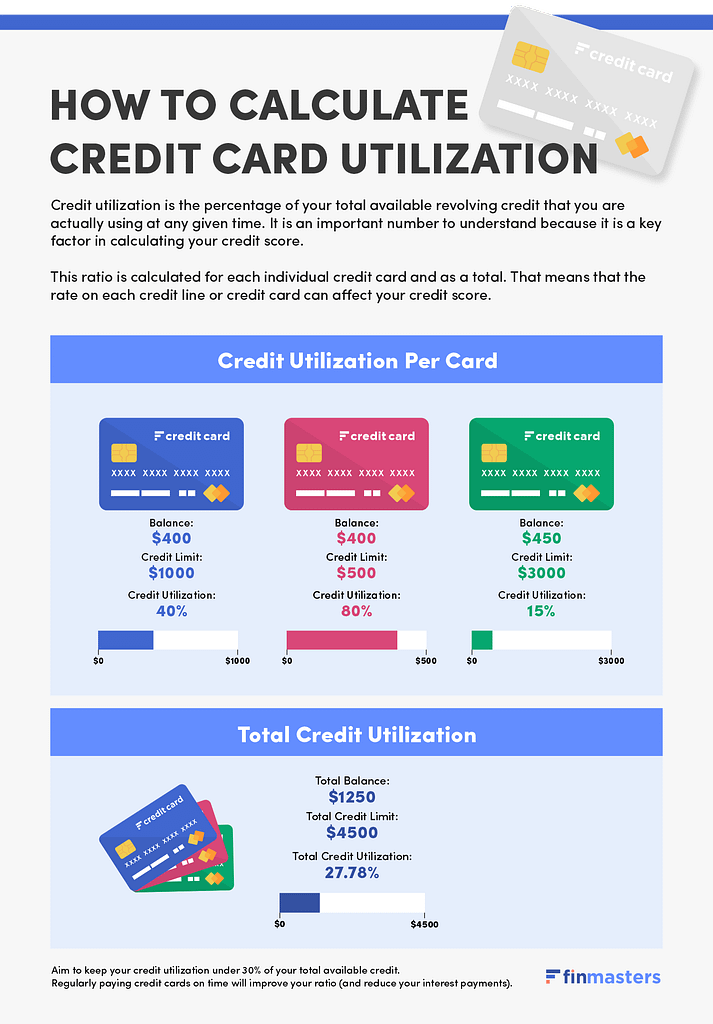
What Is a Good Credit Utilization Ratio?
Aim to keep your balances under 30% of your total available credit. This will keep you firmly in the “good” category. Regularly paying credit cards on time will improve your ratio (and reduce your interest payments).
Research from Experian shows that users with good credit scores (740 to 799) have an average credit utilization of 12.47%. Users with credit scores of 670 to 739 average 32.6%.[1]
🤔 What Is the Best Credit Utilization Ratio?
The best credit utilization ratio is under 10%.
While 0% might seem like a good credit utilization score, that simply means you are not using any credit. Creditors and lending institutions like to see that you use credit responsibly, not avoid it altogether. Under 30% is good. Under 10% will have a greater positive impact on your credit score.
Research from the credit bureau Experian has shown that users with the highest credit scores, 800 to 850, have an average credit utilization of 5.7%[1].
How Does Credit Utilization Affect Your Credit Score?
Your credit score is made up of a number of factors, including credit utilization rate, payment history, inquiries, public records, credit history, and credit mix. Your credit utilization ratio makes up around 30% of your total credit score. Even with perfect payment history, long credit history, and a good credit mix, your credit score could be reduced by a high ratio.
A credit utilization rate under 30% is acceptable. Under 10% is good, and under 5% is excellent.
👉 A credit utilization under 30% will not have a negative impact on your credit score.
This ratio is calculated for each individual credit card or line of credit and as a total. That means that the rate on each credit line or credit card can affect your score. Even if your overall utilization is low, one maxed-out card can harm your credit.
👉 For example:
Imagine that you have 5 credit cards, each with a $10,000 limit.
That would make your total credit limit $50,000.
Now imagine that you have an $8000 balance on one card.
Your overall credit utilization is 16% which is good.
Your credit utilization on that one card is 80%, which is bad. That can still dent your score.
If you had the same 5 credit cards, and you had a $1000 balance on each card, your overall rate would be 10%, and the rate on each card would also be 10%.
When Is Credit Utilization Calculated?
Credit card companies usually report to credit bureaus once a month, or once during every 30-day billing cycle. This usually happens about 7 to 15 days after the statement closing date, but that varies with the card issuer.
Payments made or changes to total credit are reflected in 30 to 60 days. If you have paid off a significant portion of debt on revolving credit, expect to see it in your credit score in about a month, depending on when the institution reports and when the credit score is updated.
☝️ If you have a high balance on a card at the time the card company reports, you could see your ratio spike even if you pay that balance in full on or before the due date.
👉 You can avoid this by keeping your balances low or by making several payments each month.
Ways to Improve Your Credit Utilization Ratio
There are five ways to lower your credit utilization.:
- Pay off debt
- Redistribute debt
- Open a new line of credit
- Ask for a credit limit increase.
- Keep old cards open.
Here is how to use each of these.
1. Pay off Debt
Paying off debt is the simplest and most effective way to improve. In addition to paying off credit card debt, focus on paying off any other revolving lines of credit like store loans or layaways.
2. Redistribute Debt
If it is not possible to pay off debt in the short term, another strategy is to redistribute debt. You can do this by transferring a balance to a different credit card. Ideally, aim to have no single card with more than 30% of total available credit. That means if the credit card has a line of credit of $10,000, try to put not more than $3000 on it.
💡 Make a strategy before you add expenses or additional debt. If you have to make a charge you won’t be able to pay off right away, try to put it on a credit card or line of credit that does not already have 30% of total available credit in debt.
3. Open a New Line of Credit
When you open a new line of credit, such as a credit card, you get two advantages. First, it increases the total available credit. Second, many credit cards offer 0% interest for a set period of time after opening. This is typically three months to a year. This gives you an opportunity to make a balance transfer, improve your credit utilization rate, and avoid interest while paying off debt.
⚠️ Opening too many lines of credit in a short space of time can hurt your credit score. But, if you haven’t opened a credit card for some time, this is an effective strategy.
4. Ask for a Credit Limit Increase
One of the fastest ways to lower your credit utilization is to ask your card issuer to increase your credit limit. Many card issuers are willing to add a bit to your limit, especially if your payment record is good.
If you had a card with a $5000 limit and your balance was $2000, your ratio would be 40%, not so good. If your card issuer increased your credit limit to $8000, the same balance would give you a rate of 25%, much better.
⚠️ You’ll need to resist the temptation to spend more with that higher limit. That won’t help!
5. Keep Old Accounts Open
If you have old credit cards you aren’t using, don’t close them. They will add to the average length of your credit history, and their credit limits will add to your total and help your credit utilization.
💡 The only exception to this rule would be cards with an annual fee. If you’re paying to keep a card that you aren’t using it might not be worth the benefits you gain.
Learn More: The 15/3 credit card payment method can help you keep your credit utilization where you need it to be. Check out our guide to the strategy here: The 15/3 Credit Card Payment Hack: How, Why, and When It Works.
FAQs
Credit utilization accounts for 30% of your credit score. If you were to make a pie chart of credit score calculation, it would account for just under ⅓ of the pie.
80% is not a good credit utilization rate, and can have a negative impact on your credit score. If the 80% is on one card or revolving account and you have other lines of credit with substantially lower credit utilization, the impact on your score will be less.
For example, if you have one credit card at 80% and three other credit cards at 5%, the total on all four cards would be 23.75%, which is still considered a good ratio. 80+5+5+5=95% / 4 = 23.75%
While a lower credit utilization score is nearly always better, a rate of zero often indicates that your account is not active. Active accounts have a higher weight in credit score calculations. For this reason, it is often better to have a very low credit utilization, such as 1%, rather than zero.
The Bottom Line
Credit utilization is a key part of your credit score. It’s also a part of your credit score that you can control and change. If you’re looking to improve your credit score, lowering your credit utilization rate is one of the most effective ways to do it.

